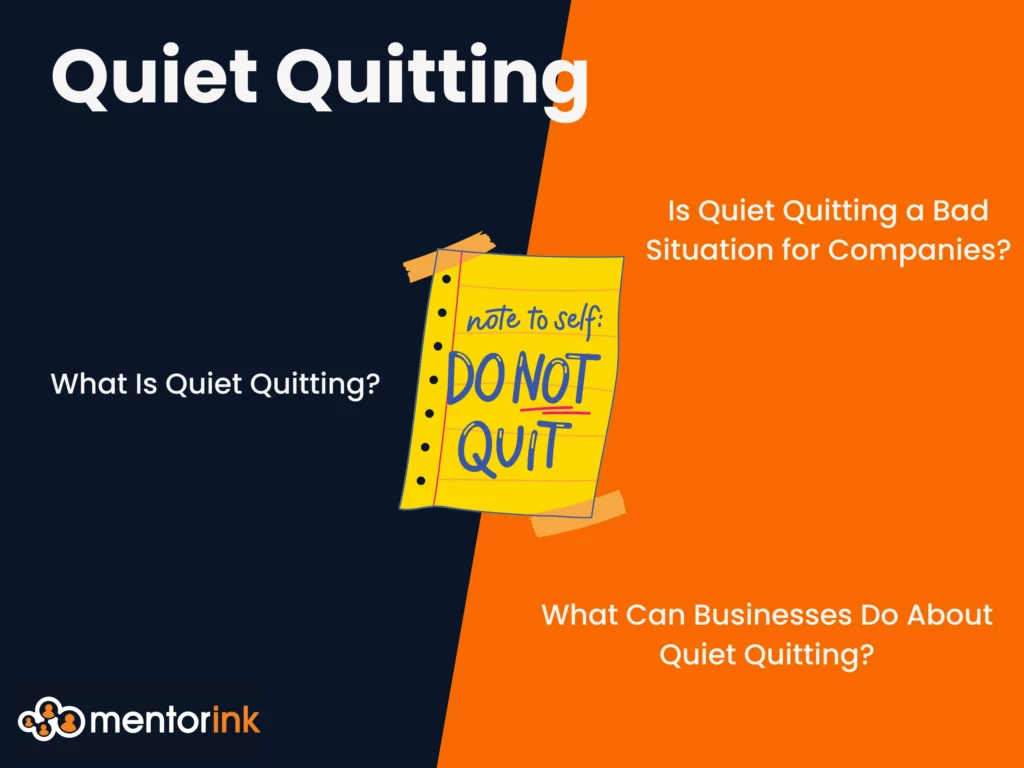
The idea of “quiet quitting” has been getting a lot of attention in the workplace recently. At first glance, this concept might seem like someone is secretly leaving their job, but quiet quitting is actually a different thing. This is when employees don’t officially resign but mentally disengage from their roles, only doing the bare minimum to meet their job responsibilities. Understanding this concept is crucial for both employees and employers when it comes to workplace satisfaction and productivity.
What Is Quiet Quitting?
Mentally checked out, but still showing up and doing the bare minimum. That’s what quiet quitting looks like. These employees often feel unmotivated, undervalued, or disconnected from their work. This situation can lead them to stop putting in extra effort or going beyond what is strictly necessary. With quiet quitting, the employee physically stays with the company but makes the choice to disengage from their work.
According to Gallup, “U.S. employee engagement took another step backward during the second quarter of 2022, with the proportion of engaged workers remaining at 32% but the proportion of actively disengaged increasing to 18%. The ratio of engaged to actively disengaged employees is now 1.8 to 1, the lowest in almost a decade.”
Data from the renowned research company Gallup shows that a wave of passive quitting is among the top factors affecting companies since 2022. There are a number of reasons why quiet quitting might happen. Some employees might feel burned out because they’re overloaded with work or don’t get enough recognition. Or maybe they feel like their job isn’t in line with their personal goals or values. Another reason for quiet quitting is a lack of growth opportunities or dissatisfaction with the company culture. Even if these employees don’t say anything, they can still have a big impact on workplace morale and productivity.
Is Quiet Quitting a Bad Situation for Companies?
It depends on how you look at it, whether quiet quitting is a bad thing. From an employee’s perspective, it can be seen as a way of looking after yourself. Instead of pushing themselves to the point of burnout, they choose to focus on their well-being by limiting their work to what’s needed and no more.
This is why quiet quitting can be a helpful way for employees to keep a good work-life balance and look after their mental health. However, although it may seem like you are reducing your workload with a passive quitting, in fact, it can also mean the beginning of a break with your job.
But from an employer’s point of view, quiet quitting can be a bit of a problem. When employees aren’t engaged, they’re less likely to contribute to team efforts, innovate, or go the extra distance to meet business objectives.
This lack of engagement can lead to lower productivity, less team spirit, and even a negative impact on the company’s profits. On top of that, other employees might start to feel like they can do the same, which could lead to a bigger culture of disengagement within the company.
What Can Businesses Do About Quiet Quitting?
In order to address the issue of quiet quitting, companies are advised to focus on the creation of an environment in which employees feel valued, motivated, and engaged. The following strategies may prove beneficial in this regard:
Improve Communication at the Workplace
It’s important for management and employees in a company to be able to communicate openly and honestly with each other. It’s good to have regular check-ins and feedback sessions so that any issues or concerns that employees might have can be identified. Let your employees know you want to hear from them and give them a way to share their ideas. This can help them feel like they belong and are involved.
Offer Growth Opportunities
One of the main reasons people quit their jobs without saying anything is because there aren’t any opportunities for growth or advancement. It’s important for businesses to invest in employee development programs, offer clear career paths, and encourage continuous learning. If companies give their employees chances to grow professionally, they’ll stay motivated and engaged.
Recognize and Reward Efforts of Your Employees
If employees feel their hard work is recognized, they are more likely to stay engaged. A recognition program that celebrates achievements can boost morale. Showing appreciation can prevent employees from quitting.
Promote Work-Life Balance
Burnout is a major cause of quiet quitting. To address this, businesses can promote a healthy work-life balance. This means offering flexible work hours, remote work options, and encouraging employees to take their full vacation days. By supporting work-life balance, companies can reduce burnout and keep employees engaged.
Foster a Positive Workplace Culture
A positive and inclusive workplace culture can be considered as a critical factor in employee engagement. Companies can create an environment where employees feel respected, supported, and part of a community. This includes promoting teamwork, encouraging diversity, and promptly addressing any toxic behaviors.


